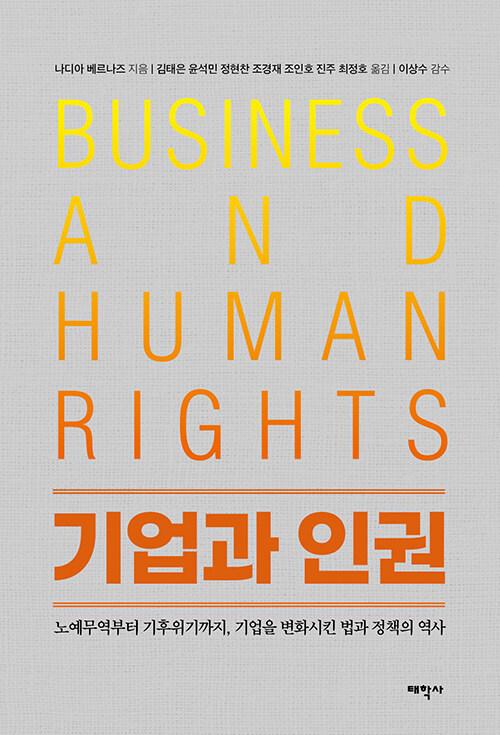책 이미지

책 정보
· 분류 : 외국도서 > 경제경영 > 기업윤리/에티켓
· ISBN : 9781138833562
· 쪽수 : 350쪽
· 출판일 : 2016-04-13
목차
Chapter 1: The Relationship of Human Rights to Business 1.1 Business and Human Rights in Context (Justine Nolan) 1.2 Making the Business Case for Human Rights: An Assessment (Dorothee Baumann-Pauly & Michael Posner) 1.3 Bhopal: The Saga Continues 31 Years on (Surya Deva) 1.4 Rana Plaza: The Collapse of a Factory in Bangladesh and its Ramifications for the Global Garment Industry (Justine Nolan) Chapter 2: The Evolution of Business & Human Rights 2.1 Mapping the Movement: The Business and Human Rights Regulatory Framework (Justine Nolan) 2.2 The United Nations "Protect, Respect, Remedy" Framework and Guiding Principles (Chip Pitts) 2.3 Incorporating Human Rights: Lessons Learned, and Next Steps (John Gerard Ruggie) 2.4 Towards a Business and Human Rights Treaty? (Arvind Ganesan) Chapter 3: Business and Human Rights: Implementation Challenges 3.1 From Side Show to Main Act: Can Business and Human Rights Save Corporate Responsibility? (Florian Wettstein) 3.2 Implementing Human Rights in Global Business ? High Performance with High Integrity (Ben Heineman) 3.3 Human Rights "Intrapreneurs": Challenges and Keys to Success (Christine Bader) 3.4 The Social License ? One Way of Thinking about Business and Human Rights (John Morrison) 3.5 Salient Human Rights Issues: When Severe Risks to People Intersect with Risks to Business (Caroline Rees and Rachel Davis) Chapter 4: Defining & Implementing Human Rights Standards Industry by Industry 4.1 Setting and Enforcing Industry-Specific Standards for Human Rights ? the Role of Multi-stakeholder Initiatives (MSIs) in Regulating Corporate Conduct (Dorothee Baumann-Pauly, Justine Nolan, Sarah Labowitz & Auret van Heerden) 4.2 The Fair Labor Association (FLA) ? Improving Workers Rights in Global Supply Chains (Auret van Heerden) 4.3 The Global Network Initiative ? How Can Companies in the Information and Communications Technology Industry Respect Human Rights? (Michael Samway) 4.4 Extractives and Multi-Stakeholder Initiatives:The Voluntary Principles on Security and Human Rights; The Extractive Industries Transparency Initiative & The Kimberley Process Certification Scheme (Scott Jerbi) 4.5 The Emergence of the International Code of Conduct for Private Security Service Providers (Anne-Marie Buzatu) 4.6 Standard Setting for Agriculture (Michael Posner) 4.7 The Coalition of Immokalee Workers and the Campaign for Fair Food: The Evolution of a Business and Human Rights Campaign (Joanne Bauer) Chapter 5: Key constituents that drive the implementation of Business and Human Rights 5.1 The Role of Civil Society in Business and Human Rights (Chris Jochnick & Louis Bickford) 5.2 Workers [Title tbc] (Barbara Shailor) 5.3 Shopping for a Better World: How Consumer Decisions Can Help to Promote Sustainability and Human Rights (Guido Palazzo, Felicitas Morhart & Judith Schrempf-Stirling) 5.4 Investors: Models and Strategies for Engaging with Human Rights (Mary Dowell-Jones) 5.5 Thinking Long-Term: Investment Strategies and Responsibility (Mattie Bekink) 5.6 Investors and Human Rights: Values, Risk and Materiality (Bennett Freeman) Chapter 6: Accountability and Remedy Mechanisms 6.1 The Meaning of accountability (Simon Zadek) 6.2 Business and Human Rights Litigation in United States Courts Before and After Kiobel (William Dodge) 6.3 Holding Multinational Corporations Accountable for Human Rights Violations: Litigation outside the United States (Christine Kaufmann) 6.4 Access to Remedy: Non-Judicial Grievance Mechanism (Kristen Genovese) 6.5 The Rise of Non-Financial Disclosure: Reporting on Respect for Human Rights (Amol Mehra & Sara Blackwell) 6.6 Mandatory Human Rights Reporting (Anthony Ewing) Chapter 7: Global Rules, Private Actors: Future Challenges for Business and Human Rights 7.1 We Live in a World of Global Supply Chains (Richard M. Locke) 7.2 The Future of Business and Human Rights: Challenges and Opportunities (Dorothee Baumann-Pauly, Sarah Labowitz, Justine Nolan and Michael Posner)



























